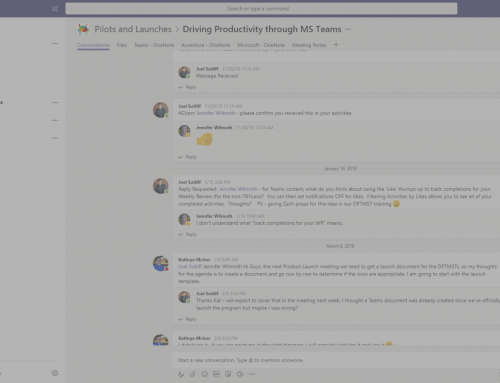
By Sally McGhee
Originally featured on Forbes
“Productivity” is a constant workplace buzzword, but it’s often an ambiguous subject that the business community groups together with time management. Most organizations aren’t seeing productivity for what it really is, which is a broad cultural change across an entire organization that often demands more thought and leadership to implement successfully. Productivity can be viewed through the same lenses that lean and Six Sigma methodologies are: It’s a system for improvement that’s culturally embraced, measured and constantly optimized to be truly successful within companies.
I’ve been working in the productivity field for decades, and through my research at various companies around the world, I’ve identified five important disciplines for productivity. When these five disciplines are consciously focused on at an individual, team or organizational level, they can create cultures of sustainable productivity.
Alignment
I refer to alignment as how teams and companies “row in the same direction” with their organizational and team goals, and with each other in task completion. Alignment is not the same as agreement. Just because someone agreed to a task doesn’t mean they’re aligned with why they’re doing it. An aligned organization gives its employees clear and measurable goals so they always know how their roles impact the rest of the company.
Additionally, organizations can strive for alignment by ensuring that there’s an open forum of communication for every employee, not just the senior-level ones. It’s usually impossible for a team to be aligned without the relevant context and understanding, as this comes from communicating with each other in a different way — leaders communicating openly with staff and ensuring that their teams feel comfortable enough to do the same. Further, it entails reviewing past team performance, learning what did and didn’t work and then going deeper into how to increase their team performance through more meaningful discussion of past results.
Accountability
Accountability gives individuals the opportunity to dig deeper by holding themselves and others responsible for their actions and deliverables. A culture of accountability can, in fact, be very motivating and supportive versus a “stick to hit people with.” However, I’ve found that most organizations don’t hold their staff to higher levels of accountability. They allow many opportunities for greater accountability to slip through the cracks.
Accountability education is important, and there are many levels of accountability, each of which applies differently to different roles. Executives will likely be treated differently than entry-level employees. Understanding the appropriate levels of accountability and the behaviors attached to them can be key.
Accountability also can require some coaching as I’ve noticed that most of us don’t want to be held accountable or hold others accountable. However, with routine and honest communication given in an empowering way, employees can be inspired to greater levels of accountability, not just to themselves but to their team and organization.
Workflow Management
Workflow management is a fancy way of saying how information is received, processed and acted on from both an individual and systems perspective. For most people, this is how we process and organize our email, meetings and goals every day. We live in such a fast-paced society that people seldom slow down to ask themselves, “Is there a better way to do this?” Whether you’re ready to admit it or not, almost everyone’s workflow can be reduced and standardized to not only move quicker but also to produce results sooner.
Productive organizations provide the tools their employees need to be proactive about their tasks, meetings and emails rather than allowing them to be stuck in a state of reactiveness. Of course, it’s not possible for every area of work to be optimized, but the work that can be should be to support a more productive culture and give back valuable time and focus.
Digital Fluency
Technology is constantly changing and evolving, which is causing a lot of people to fly by the seat of their pants when it comes to using their digital tools. Most companies are offering education that shows the overarching features and benefits of tools; however, staff members are often left to their own devices to work out how to use their tools to best serve their own role and outcomes.
For a person to be the most productive, they likely need to know the most efficient way to use digital tools for their specific tasks. Almost every tool has a long list of features, but not all of them need to be used by every employee. Knowing what tool to use when can be key given that we now have so many options. Where do we store information? Where do we record actions and decisions? How do we effectively cross-function and collaborate as a team?
Well-Being
According to a 2015 research paper by professors at Harvard Business School and Stanford, burned-out employees cost between $125 billion and $190 billion each year in health care spending in the United States. Given these statistics, it may not be surprising that individuals are more interested than ever in learning how to be healthier at work and at home.
Productive companies often have cultures where employees know that they have permission to initiate conversations about their work-life balance, and they’re not afraid to voice any concerns they may have about it. Of course, there may be times when work-life balance fluctuates, and individuals are spending more time than usual working, but organizations can emphasize the importance of employees living the most balanced lives possible. We can create more productive cultures through caring and talking about well-being.
Productivity Is An Organizational Learning Journey
Organizations can work on these disciplines individually, but they’re all interconnected. When a company starts working on all five of them in unison, they begin strengthening each other. If an organization is overlooking one discipline, it could negatively impact the other four disciplines to some degree. Productivity is an organizational learning journey, and if given the emphasis it deserves, it can be one of the single biggest impacts on a company’s bottom line.
What do you think? Do you see evidence of these disciplines working or not working in your company?
Increase Your Accountability Through Our Cultivating Accountability Course
It is important to know how your staff currently handles accountability given most people do not like to be held accountable nor do they like to hold others accountable. This program is tailored to the audience, their role, and the level of accountability they need to engage in to support the organization’s culture and goals.





